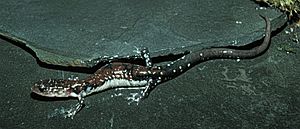Rich Mountain salamander facts for kids
Quick facts for kids Rich Mountain salamander |
|
|---|---|
 |
|
| Conservation status | |
| Scientific classification | |
| Genus: |
Plethodon
|
| Species: |
ouachitae
|
The Rich Mountain salamander (Plethodon ouachitae) is a cool type of salamander that lives in the Ouachita Mountains. You can only find it in this area, which is in western Arkansas and eastern Oklahoma. These salamanders like to live in forests that aren't too hot or too cold. Sadly, their homes are shrinking because of habitat loss.
Contents
What Does the Rich Mountain Salamander Look Like?
These salamanders are quite small. They grow to about 5 centimeters (2 inches) long, not counting their tail. They have a mottled, grayish color. This helps them blend in with their surroundings, making it hard for other animals to spot them. If a predator tries to eat them, these salamanders have a special trick. They can release a yucky substance from glands on their backs. This bad taste helps scare away animals that want to eat them.
Where Do Rich Mountain Salamanders Live?
The Rich Mountain salamander was first found near Rich Mountain, east of Page, Oklahoma. This area is part of the Ouachita Mountains. These salamanders prefer forests with a mix of trees that lose their leaves in the fall. They especially like slopes that face north, where it's often wetter. You can also find them under logs, rocks, and other debris. Sometimes, they even hang out near the entrances of caves.
How Do Rich Mountain Salamanders Live?
Salamander Territories
Male Rich Mountain salamanders are very protective of their space. They will defend their territories from other male salamanders. This helps them make sure they have enough food and good spots for breeding.
Reproduction and Life Cycle
Breeding for these salamanders happens in the late autumn, winter, and early spring. They lay their eggs in burrows found in rocky areas or caves. A female salamander usually lays about sixteen eggs. She stays with them and keeps them safe until they hatch. The cool thing is, the eggs hatch directly into tiny salamanders. There is no tadpole-like stage that lives in water, like some other amphibians have.
What Do They Eat?
Young salamanders and adults live in the same places. They both search for food among the fallen leaves on the forest floor. Their diet mainly consists of small invertebrates. This includes insects and their larvae, worms, and spiders.
When Are They Active?
Rich Mountain salamanders are mostly active at night. However, if the weather is wet, you might see them moving around during the day. In the hottest months, from May to September, adult salamanders might go into a deep sleep called aestivation. This helps them save energy when food or water might be scarce. Young salamanders, though, usually stay active for at least part of this time. In the winter, they likely go into hibernation, which is a deep sleep to survive the cold. Female salamanders usually only breed every other year.
Are Rich Mountain Salamanders in Danger?
The IUCN Red List of Threatened Species helps us understand how safe different animals are. The Rich Mountain salamander is currently listed as "Near threatened". This means they are not in immediate danger, but their future could be at risk. Even though there are many of them in some places, their populations are spread out. This means a problem in one area could really hurt a local group of salamanders. They are vulnerable to habitat destruction, especially when forests are completely cut down. However, some of their living areas are in protected places, which helps keep them safe.


